September 30, 2016 Standing Take-Down Maneuver
by Gerald M. Dworkin
July 27, 1998
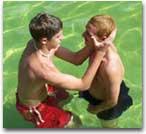

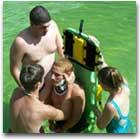

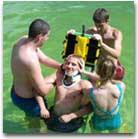
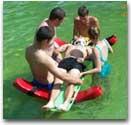
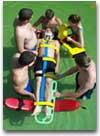
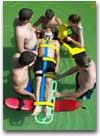
A 6-year-old child runs across the pool deck. The lifeguard stationed in the nearest elevated lifeguard stand sees the child, identifies the risk, and attempts to blow his whistle in an effort to warn the child to stop this activity immediately. However, before the lifeguard can blow his whistle, the child is in the air as she leaves the deck and jumps into the water. An adult swimmer was swimming underwater and happened to be in the path of the child. As a result, the child lands on the back of the swimmer as he was beginning to surface. The swimmer, obviously hurt by the child, stands up and begins to walk over to the pool side.
The above incident is an actual one, and unfortunately, a very common one. Because of the mechanism of injury, the lifeguard personnel must assume the possibility of a spinal cord injury and must act immediately to prevent further damage to the patient’s spine. Mechanism of Injury is defined within the American Academy of Orthopaedic Surgeons textbook, Emergency Care and Transportation of the Sick and Injured, as “The way in which traumatic injuries occur. With a traumatic injury, the body has been exposed to some force or energy that has resulted in permanent damage or even death.” If the lifeguards in the above case were to allow the patient to walk out of the pool and to sit or lie down on the deck or chair, the patient could very well aggravate an already compromised spine. Therefore, the lifeguard personnel must act quickly to minimize any additional movement to the patient’s spine while the patient is in the water, and must immobilize the patient effectively to a rigid backboard prior to removal.
The Standing Take-Down Maneuver is a technique which all Lifeguard personnel should know in order to deal with a suspected spinal injured patient who is found in a standing position. This same technique is taught in many EMT and First Responder courses, since many potentially injured patients of automobile accidents are found standing outside of their vehicle by the time the EMS personnel respond to the scene of the incident.
The procedure is performed as follows:
- Rescuer 1 approaches Patient from the front and takes in-line stabilization of the patient’s head and neck until Rescuer 2 is available to take over in-line stabilization. (Note: We recommend approaching the Patient from the front, rather than the back so the patient does not have the tendency to attempt to turn his/her head toward the Rescuer when contact is made or when verbal communication is initiated.)
- Rescuer 2 takes over in-line stabilization from the rear of the patient. (Note: Rescuer 2 must maintain in-line stabilization with his/her fingers away from the cervical spine area so that the cervical collar can be easily applied.)
- Rescuer 1 sizes and applies an appropriately sized cervical extrication collar.
- Rescuers 1 and 3 place a backboard against the patient’s back by sliding the backboard up through or down through the arms of Rescuer 2.
- Rescuer 2 maintains the Patient’s head in-line and against the cervical immobilization device (CID) base pad.
- Rescuers 1 and 3, while standing up and facing the Patient (one on each side of the Patient), place their inside hand under the Patient’s armpit, in between the Patient’s arm and torso. (Note: They must also reach up and grab the highest backboard handhold when performing this skill.) Also, they place their outside hand against the Patient’s shoulders, just under the Clavicle, in order to keep the Patient’s shoulder blades and torso against the backboard.
- On command, the patient is transferred from a standing position to a horizontal position while Rescuer 2 rotates his/her hands in order to allow the patient to be easily lowered to a horizontal position. At the same time, it is critical that Rescuer 2 keep the Patient’s head in contact with the base pad and aligned with the rest of the body and backboard. Once the patient is horizontal, it is critical that the lifeguard at the patient’s head (Rescue 2) continually monitor the patient’s airway and to protect and shield the airway from wave action, especially in surf or wave pools.
- Once the Patient is in a horizontal position, the Patient may be slid higher or lower on the board as necessary. We also recommend the use of supplemental flotation to help stabilize the backboard and victim during both shallow and deep water rescues. A rescue tube placed under the shoulder section of the backboard, with another tube placed under the foot section of the board provides an excellent flotation platform for the victim.
- The Patient’s torso is then immobilized to the backboard, followed by the Patient’s head. The torso straps should be secured first, working from the top of the chest, down to the fee. All straps are rechecked for tightness before the patient’s head is secured. When the immobilization process is completed, the patient may then be removed from the water with all movement being in a head-first direction.
Lifeguards must recognize and immediately react to any incident, especially those involving respiration, circulation, and spinal cord emergencies. Trauma to the spinal cord can be catastrophic. Therefore, if the mechanism of injury suggests the possibility of a spinal cord injury, lifeguard personnel must manage the incident appropriately in order to prevent other patrons, or the patient himself from compromising the injury further. The Standing Take-Down Maneuver is a very simple procedure to learn and should be part of all Lifeguard pre-service and in-service training programs. This procedure may be applied in shallow water or on land.
(Note: We would like to thank the Crotched Mountain Rehabilitation Center of Greenfield, NH and the Harrisville (NH) Volunteer Fire Department for their assistance in the demonstration of these skills. Equipment demonstrated includes the Lifesaver CID, an Ultra-Vue Backboard, a Philadelphia One-Piece Cervical Extrication Collar, and a Backboard Immobilization Harness System.)


